
Hortus Conclusus
- Info
- Catalog Travelogue Nele Ströbel
- DG Gallery Munich
- Museum Regensburg
- Museum Paderborn
- Marienstern monastery garden
- Swabian Gallery Oberschönenfeld
- "The circling Hortus" Art Forum HerzJesu Cologne
- "Hortus Conclusus" in "Boredom in Paradise" Bonn
- "The Other Garden" City Museum Deggendorf
- "The Other Garden" Gallery in Körnerpark
- Urban gardening in Neukölln
Following the book and exhibition project “Hortus Conclusus, a spiritual space becomes an image”, in which I worked on the enclosure gardens of women’s monasteries: http://www.nele-stroebel.de/hortusc/dg.htm
I am preparing a Exhibition on 260 m² in the Museum Deggendorf: For the Landes Gartenschau, a walk-in diary on urban gardening and guerrilla gardening is being created in Neukölln, my new studio. For this, a catalog is published in the series of the museum: 84 pages, art duck with many illustrations and texts by scientists and artists about the garden in the city. Published by Stadtmuseum Deggendorf and Nele Ströbel. The book is published as an art project in the context of the exhibition “The Other Garden” in the Stadtgalerie at the Stadtmuseum Deggendorf.
Gardens are emblematic spaces with multiple connotations. They inspire my work on the Hortus Conclusus in the city. With this “walk-in diary” I tell about the urban gardeners.
Specially made clay and wooden objects report on walls and floors from different stations on my city walk. The drawings and watercolors are installed on the wall via tapes. The exhibition and catalog book feature works that explore the pictorial arrangement and reproduction of plants and trees. The title Hortus Conclusus, which refers to the closed garden of Mary depicted in historical paintings, also means to me a closed world of my own. In this I work on different levels, some of which are closed, withdrawn, or can be tested outside, on stages.
My Hortus Conclusus is a space where reality and fiction collide and the city is reinvented. The exhibition will travel. The next place will be Berlin. The architecturally designed and engineered vertical garden is a tremendously exciting and significant aspect of the dense city and should not be missing from this book and exhibition!
Catalog Travelogue Nele Ströbel
|
A mental space becomes an image Exhibition and book project |
|||
|
Touring exhibitions with site-specific spatial installation on the theme of the Klausurgarten with wood and terracotta sculptures, photographs, loops and drawings. The hortus conclusus, the enclosed garden, was one of the most popular motifs in medieval art, drawing on the Song of Solomon to interpret the Virgin Mary as a fertile, enclosed garden. This book and traveling exhibition explored the biblical roots of the garden motif and the hortus conclusus in art history. It sets out the meaning of the garden as a vision of paradise and as a space for contemplation and recreation in the monastic enclosure today. Based on the idea and concept of Nele Ströbel, the photographer Ulrike Myrzik and the sculptor visited the “horti conclusi” of 15 women’s convents between July and October 2006. Through conversations with the nuns, photographs, drawings and their transformation into sculptural works, they traced the questions “How can a place store memory?” “Are there specific systems of measurement and order of enclosed gardens?” “How can spirituality be lived and spatially experienced in the 21st century?”. |
|||
View of the exhibition in the Regensburg Museum
Invalid shortcodeView of the exhibition at the Museum Paderborn
Invalid shortcodeExhibition participation: “Hortus Conclusus” in “Boredom in Paradise
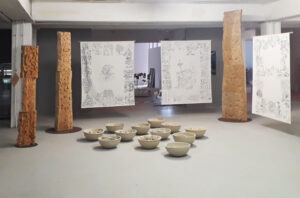
frauenmuseum@bonn-online.com
“Hortus Conclusus” in “Boredom in Paradise” www.frauenmuseum.de runs until 30.10
Video tour through the exhibition participation in Bonn
.
Invalid shortcode”The Other Garden” Urban Gardening or the Hortus Conclusus in the Neighborhood .A multimedia urban walk. The research:
On my urban walks through the botanicals of downtown, I have noticed different forms of gardening and gardening in the city:
Especially in Neukölln there are many guerrilla gardeners who plant and cultivate tree discs, entire green spaces or empty lots: Out of love for plants , out of creativity, out of social romanticism, out of love for urban space, out of personal commitment, out of joy of experimentation, out of sympathy, out of longing for simple, manageable activities, out of desire for outdoor activity, as a leisure activity, out of necessity, as an economic and sustainable gain, as a contact exchange for the whole family, as a cultural setting, as a political sign, as a place of longing, as a utopian experiment, as a protest against neglect, thoughtlessness, unkindness, as a consolation for many a thing, as a sign of hope, as an ecological setting, as a rebellion, as a work of art, as a paradigm shift, for self-awareness and study. Gardening in public spaces has many motivations.
The different garden types: The tree slice as a hortus conclusus at the roadside, between cars and the sidewalk: Here, with a small fence, bench, garden plants, people lovingly and often also with financial commitment fight for a piece of designed nature in front of the door. A permanent mission against dog excrement, drunkards and naughty neighborhood visitors. Pure guerrilla gardening.
The allotment gardens in the middle of the city with different strict rules. It’s like the cemeteries: from meticulous order to total anarchy, everything is there. Here is also harvested a lot of fruit, jams cooked collectively. Some people live here all summer and sublet the neighborhood apartment for a living. Some stay even in winter, although the water is turned off. Arborists and dacha colonies like
“people’s gardens”
,
Garden colony “Am Marienfelder Weg
have adventurous names, there I still collect.
The collectively organized interim uses of brownfield sites such as Prinzessinnen Gärten, Kids Garten and Tempelhofer Freiheit . The wild gardens and Wagenburgen along the
Landwehrkanal, Neuköllner Schiffahrtskanal
,
Teltowkanal
.
The classic park like
Volkspark Hasenheide
,
Körnerpark
and Britzer Garten. The use of the family grave as a hortus conclusus and/ or weekend dacha: half of Neukölln’s eight cemeteries are now protected as garden monuments. Otherwise, a lively diversity prevails: the arrangement and design of the graves are of breathtaking liveliness. Gravesites feature miniature parks, groves, raised beds, cannabis plantings, Ikea furnishings, grave goods from pink Barbie horse-drawn carriages to police cars. Entire miniature mosques replaced the classic tombstone, Buddha statues between meticulously cut boxwood hedges and meter-high sunflowers. Lavender bushes nourish urban bees. Parasols and garden benches provide comfort for grave visitors. Many a cellophane face on A4 is the only grave decoration. In the case of anonymous burial plots, portraits are often pasted on flower vases. A bouquet of carnations, a jar of pickles and grandma on the sofa with her dog on it. Some places: St. Thomas churchyard at Leinestraße subway station, St. Jacobi, St. Michael, New Churchyard of Luisenstadt Parish, Churchyard V of Jerusalem and New Church, St. Thomas I and Jerusalem and New Church V, Garden Monument Emmaus Churchyard, Churchyard of Jerusalem and New Church, New Garrison Cemetery and Turkish Cemetery.
The photography and drawing on site
On my urban walks through the very exotic urban greenery of Neukölln and Kreuzberg, I did a lot of drawing, photographing and talking to urban gardeners. There are 3 video loops set to music that are projected in a circle onto a white cube:
The Cemetery and Watering Can Loop with Life and Death by the Balanescu Quartet. The tree slices and flower window loop Hortus Conclusus, with the mysteries sonatas of Lyriarte. The nomadic loop over Tempelhoferfeld, princess and kids guards with Belenge music from West Africa.
Space installation with wood and terracotta sculptures, photographs, video loops, and drawings.
.jpg)
.jpg)
.jpg)
.jpg) “The Other Garden” The City as Workshop in Flusser’s Sense
“The Other Garden” The City as Workshop in Flusser’s Sense
Urban Gardening or the Hortus Conclusus in the Neighborhood
A multimedia city walk
The research
In my forays into urban botany, I have noticed different forms of gardening and gardening in the city:
Especially in Neukölln, there are many guerrilla gardeners who plant and cultivate tree grates, entire green spaces, or empty lots:
Out of love for plants, out of creativity, out of stubbornness, out of social romanticism, out of love for urban space, out of personal commitment, out of the joy of experimentation, out of sympathy, out of a longing for simple, manageable activity, out of a desire for outdoor activity, as a leisure activity, out of necessity, as an economic and sustainable gain, as a contact exchange for the whole family, as a cultural setting, as a political sign, as a place of longing, as a utopian experiment, as a protest against neglect, thoughtlessness, unkindness, as a consolation for many a thing, as a sign of hope, as an ecological setting, as a rebellion, as a work of art, as a paradigm shift, for self-awareness and study.
Gardening in public spaces has many motivations.
The different types of gardens in the neighborhood
The tree slice as a hortus conclusus at the roadside, between cars and the sidewalk: Here, with a small fence, bench, garden plants, people lovingly and often also with financial commitment fight for a piece of designed nature in front of the door. A permanent mission against dog excrement, drunkards and naughty neighborhood visitors. Pure guerrilla gardening.
The allotment gardens in the middle of the city with different strict rules.
It’s like the cemeteries: from meticulous order to total anarchy, everything is there. Here is also harvested a lot of fruit, jams cooked collectively. Some people live here all summer and rent out the neighborhood apartment for a living. Some stay even in winter, although the water is turned off. Laubenpieper and Datschen colonies have adventurous names, the edible city lives here.
The collectively organized interim uses of brownfield sites such as “Prinzessinnen Gärten”, “Kids’ Garden” and “Tempelhofer Freiheit”.
The wild gardens and Wagenburgen along Landwehrkanal, Neuköllner Schifffahrtskanal, Teltowkanal.
The use of the family grave as a hortus conclusus and/or weekend dacha: half of Neukölln’s eight cemeteries are now protected as garden monuments. Otherwise, a lively diversity prevails: the arrangement and design of the graves are of breathtaking liveliness.


 Gravesites feature miniature parks, groves, raised beds, cannabis plantings, Ikea furnishings, grave goods from pink Barbie horse-drawn carriages to police cars. Entire miniature mosques replaced the classic tombstone, Buddha statues between meticulously cut boxwood hedges and meter-high sunflowers. Lavender bushes nourish urban bees. Parasols and garden benches provide comfort for grave visitors. Many a cellophane face on A4 is the only grave decoration. In the case of anonymous burial plots, portraits are often pasted on flower vases. A bouquet of carnations, a jar of pickles and grandma on the sofa with her dog.
Gravesites feature miniature parks, groves, raised beds, cannabis plantings, Ikea furnishings, grave goods from pink Barbie horse-drawn carriages to police cars. Entire miniature mosques replaced the classic tombstone, Buddha statues between meticulously cut boxwood hedges and meter-high sunflowers. Lavender bushes nourish urban bees. Parasols and garden benches provide comfort for grave visitors. Many a cellophane face on A4 is the only grave decoration. In the case of anonymous burial plots, portraits are often pasted on flower vases. A bouquet of carnations, a jar of pickles and grandma on the sofa with her dog.The exhibition
On my city walks through the exotic urban greenery of Neukölln and Kreuzberg, I did a lot of drawing, photographing, and talking with urban gardeners.
There are 3 video loops set to music that are projected in a circle onto a white cube:
The Cemetery and Watering Can Loop with Life and Death by the Balanescu Quartet.
The tree slices and flower window loop Hortus Conclusus, with the mysteries sonatas of Lyriarte.
The nomadic loop over Tempelhoferfeld, princess and kids guards with Belenge music from West Africa.
Gardens are emblematic spaces with multiple connotations. They inspire my work on the Hortus Conclusus in the city. With this “walk-in diary” I tell about the urban gardeners, about the playful improvised and the engineer moderately planned handling of nomadic or vertical green. Of the city as a workshop, a greenhouse as a decelerated place to dwell. In this urban laboratory, forms of the future are tested under improvised conditions.

 Specially made clay and wooden objects report on walls and floors of various stations and impressions on my city walks. The marker drawings and watercolors were created on site and once again promoted conversation with the protagonists. Installed on the wall via tapes, they are combined with photographs and object frames.
Specially made clay and wooden objects report on walls and floors of various stations and impressions on my city walks. The marker drawings and watercolors were created on site and once again promoted conversation with the protagonists. Installed on the wall via tapes, they are combined with photographs and object frames.These” fictitious circuit diagrams of urbanity” are juxtaposed with shaped, “musical” wooden fences, “lawn pieces” made of terracotta for the wall, (relief variations reminiscent of “The Great Lawn Piece” watercolor by Albrecht Dürer 1503), film sequences and “intro sculptures” (sounding, hemispherical petri dishes made of high-fired terracotta as a floor installation).
The exhibition and accompanying catalog book feature works that spatially explore the pictorial arrangement, complex representation, and reproduction of plants and trees. The title Hortus Conclusus, which refers to the closed garden of Mary depicted in historical paintings, means a closed world of its own. In this I work on different levels, some of which are closed, withdrawn, or can also be tested outside, on stages.
In the accompanying catalog book, these artistic works are reproduced alongside selected photographs and reports by dedicated scholars, activists, and designers. In this context I would like to thank all authors and interview partners, in particular Dipl. Ing. Schirin Taraz for the insights into the work of WOHA Singapore.
My Hortus Conclusus is a space where reality and fiction collide and the city is reinvented as a workshop in Flusser’s sense.
Space installation with wood and terracotta sculptures, photographs, video loops, and drawings.


“The other garden”
Urban Gardening or the Hortus Conclusus in the Neighborhood
A multimedia city walk
The research
In my forays into urban botany, I have noticed different forms of gardening and gardening in the city:
Especially in Neukölln, there are many guerrilla gardeners who plant and cultivate tree grates, entire green spaces, or empty lots:
Out of love for plants, out of creativity, out of stubbornness, out of social romanticism, out of love for urban space, out of personal commitment, out of the joy of experimentation, out of sympathy, out of a longing for simple, manageable activity, out of a desire for outdoor activity, as a leisure activity, out of necessity, as an economic and sustainable gain, as a contact exchange for the whole family, as a cultural setting, as a political sign, as a place of longing, as a utopian experiment, as a protest against neglect, thoughtlessness, unkindness, as a consolation for many a thing, as a sign of hope, as an ecological setting, as a rebellion, as a work of art, as a paradigm shift, for self-awareness and study.
Gardening in public spaces has many motivations.
The different types of gardens in the neighborhood
The tree slice as a hortus conclusus at the roadside, between cars and the sidewalk: Here, with a small fence, bench, garden plants, people lovingly and often also with financial commitment fight for a piece of designed nature in front of the door. A permanent mission against dog excrement, drunkards and naughty neighborhood visitors. Pure guerrilla gardening.
The allotment gardens in the middle of the city with different strict rules.
It’s like the cemeteries: from meticulous order to total anarchy, everything is there. Here is also harvested a lot of fruit, jams cooked collectively. Some people live here all summer and rent out the neighborhood apartment for a living. Some stay even in winter, although the water is turned off. Laubenpieper and Datschen colonies have adventurous names, the edible city lives here.
The collectively organized interim uses of brownfield sites such as “Prinzessinnen Gärten”, “Kids’ Garden” and “Tempelhofer Freiheit”.
The wild gardens and Wagenburgen along Landwehrkanal, Neuköllner Schifffahrtskanal, Teltowkanal.
The classic park like Volkspark Hasenheide, Körnerpark and Britzer Garten.
The use of the family grave as a hortus conclusus and/or weekend dacha: half of Neukölln’s eight cemeteries are now protected as garden monuments. Otherwise, there is a lively diversity:
The arrangement and design of the graves are of breathtaking vividness. 
 Gravesites feature miniature parks, groves, raised beds, cannabis plantings, Ikea furnishings, grave goods from pink Barbie horse-drawn carriages to police cars. Entire miniature mosques replaced the classic tombstone, Buddha statues between meticulously cut boxwood hedges and meter-high sunflowers. Lavender bushes nourish urban bees. Parasols and garden benches provide comfort for grave visitors. Many a cellophane face on A4 is the only grave decoration. In the case of anonymous burial plots, portraits are often pasted on flower vases. A bouquet of carnations, a jar of pickles and grandma on the sofa with her dog.
Gravesites feature miniature parks, groves, raised beds, cannabis plantings, Ikea furnishings, grave goods from pink Barbie horse-drawn carriages to police cars. Entire miniature mosques replaced the classic tombstone, Buddha statues between meticulously cut boxwood hedges and meter-high sunflowers. Lavender bushes nourish urban bees. Parasols and garden benches provide comfort for grave visitors. Many a cellophane face on A4 is the only grave decoration. In the case of anonymous burial plots, portraits are often pasted on flower vases. A bouquet of carnations, a jar of pickles and grandma on the sofa with her dog.
The exhibition
On my city walks through the exotic urban greenery of Neukölln and Kreuzberg, I did a lot of drawing, photographing, and talking with urban gardeners.
There are 3 video loops set to music that are projected in a circle onto a white cube:
The Cemetery and Watering Can Loop with Life and Death by the Balanescu Quartet.
The tree slices and flower window loop Hortus Conclusus, with the mysteries sonatas of Lyriarte.
The nomadic loop over Tempelhoferfeld, princess and kids guards with Belenge music from West Africa.
Gardens are emblematic spaces with multiple connotations. They inspire my work on the Hortus Conclusus in the city. With this “walk-in diary” I tell about the urban gardeners, about the playful improvised and the engineer moderately planned handling of nomadic or vertical green. Of the city as a workshop, a greenhouse as a decelerated place to dwell. In this urban laboratory, forms of the future are tested under improvised conditions. 

Specially made clay and wooden objects report on walls and floors of various stations and impressions on my city walks. The marker drawings and watercolors were created on site and once again promoted conversation with the protagonists. Installed on the wall via tapes, they are combined with photographs and object frames.
These” fictitious circuit diagrams of urbanity” are juxtaposed with shaped, “musical” wooden fences, “lawn pieces” made of terracotta for the wall, (relief variations reminiscent of “The Great Lawn Piece” watercolor by Albrecht Dürer 1503), film sequences and “intro sculptures” (sounding, hemispherical petri dishes made of high-fired terracotta as a floor installation).
The exhibition and accompanying catalog book feature works that spatially explore the pictorial arrangement, complex representation, and reproduction of plants and trees. The title Hortus Conclusus, which refers to the closed garden of Mary depicted in historical paintings, means a closed world of its own. In this I work on different levels, some of which are closed, withdrawn, or can also be tested outside, on stages.
In the accompanying catalog book, these artistic works are reproduced alongside selected photographs and reports by dedicated scholars, activists, and designers. In this context I would like to thank all authors and interview partners, in particular Dipl. Ing. Schirin Taraz for the insights into the work of WOHA Singapore.
My Hortus Conclusus is a space where reality and fiction collide and the city is reinvented as a workshop in Flusser’s sense.





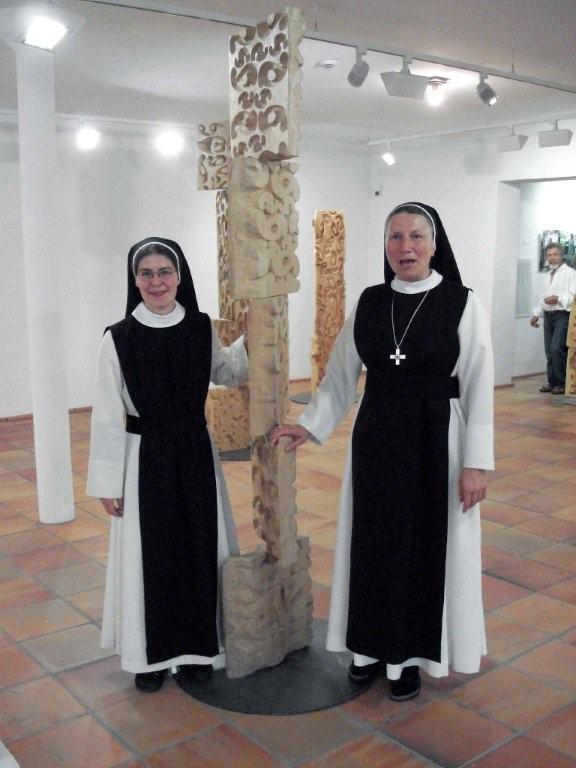




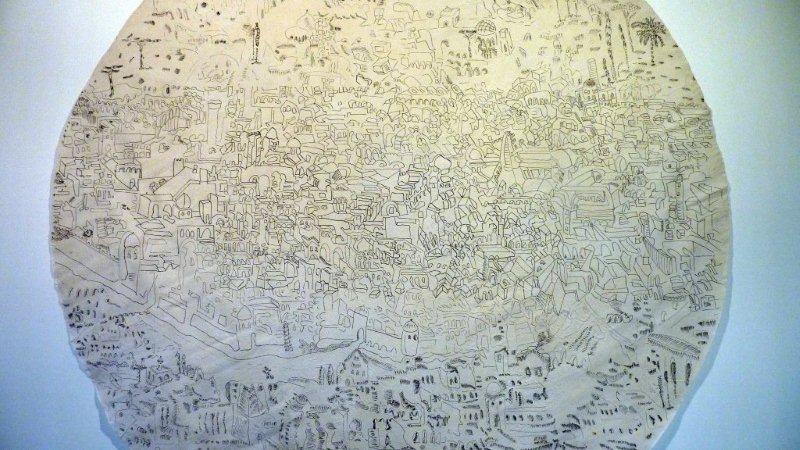


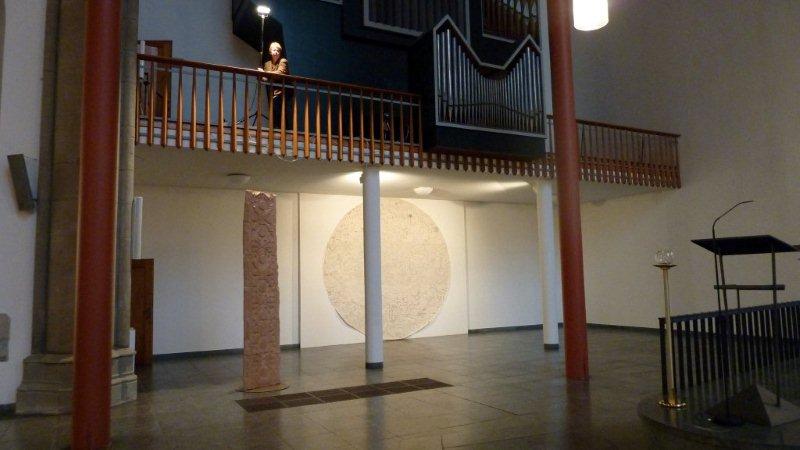


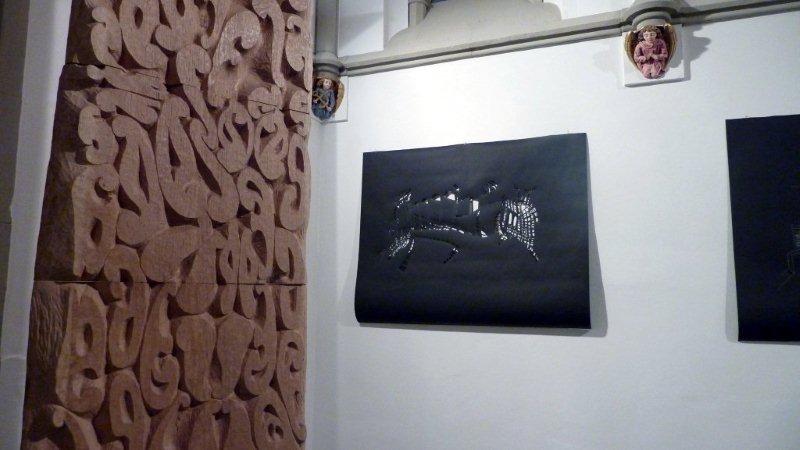



.jpg)
.jpg)